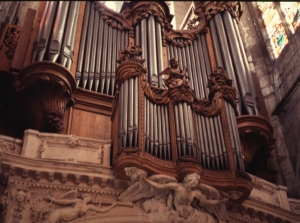

France
|
|
Organists in the United States often make the mistake of thinking of European organs as national types
without making clear distinctions within those broad categories. We are sometimes guilty of thinking of
"French reeds," or "German mixtures," for example, as though all reeds in France were alike, or all
mixtures in Geermany had the same sound. When we take a moment to think about it, we know this is not
the case, of course, but our speech habits can be persistent.
As though our occasionally careless speech were not enough, undergraduate organ students usually find their introduction to French organ music through works of Couperin, Franck, Vierne, or Langlais. Even though their music covers several centuries of French musical thought, the student can find a reassuring common characteristic:
These composers usually give instructions on registration, The basis of French organ music in a common type of instrument is an impression we absorb about French organ msuic that is valid for almost any given period in the history of the French organ. Beginning in the seventeenth century, organs were built with a consistent approach to disposition that was unmatched by any other national type. And, indeed, from the time of Couperin through major composers of the twentieth century, they have consistently given us instructions about drawing specific stops for their music. Even so, the history of the French organ is not static, and an instrument built by Thierry in 1660 is not the same as an organ by Cavaillé-Coll from 1870, and composers did not use them in the same way. This tutorial describes these types of French organ:
|
© 2000 AD, James H. Cook